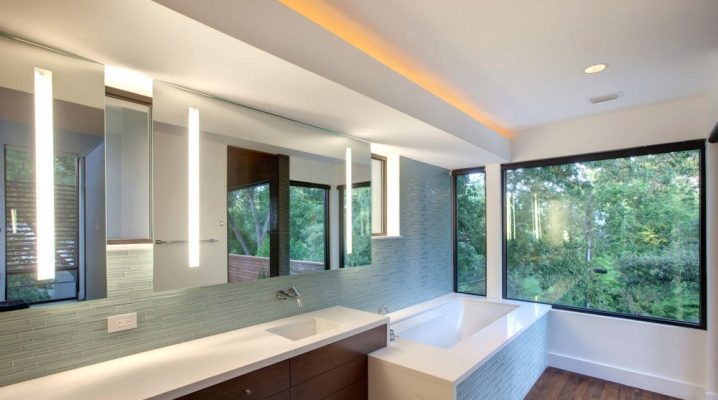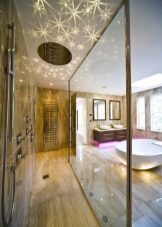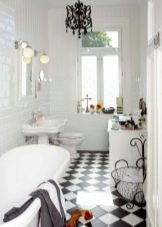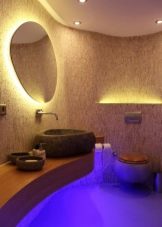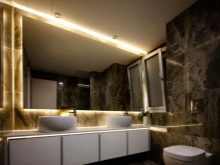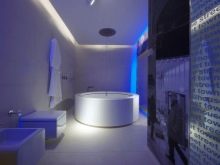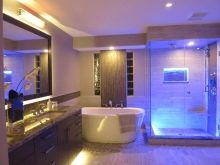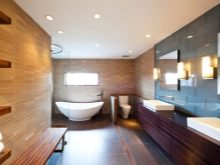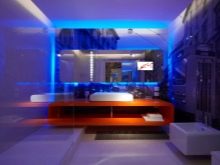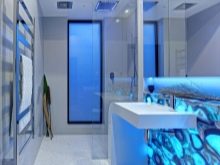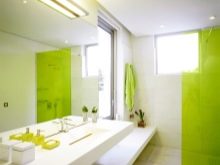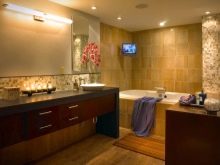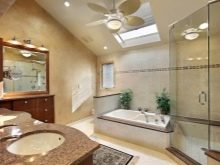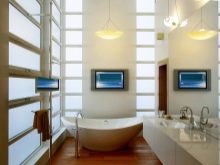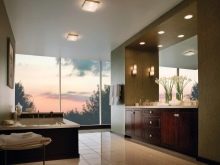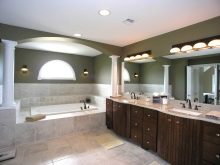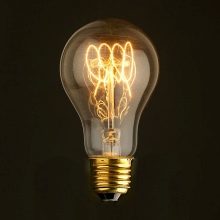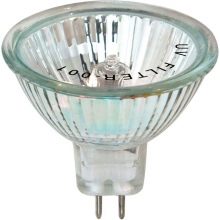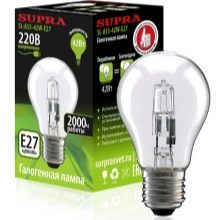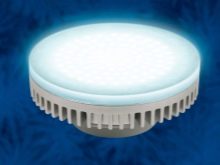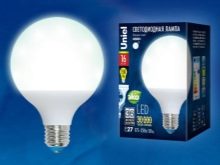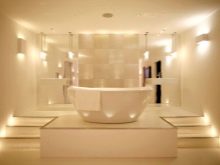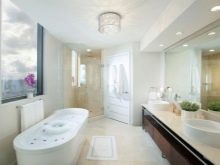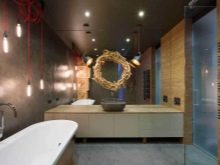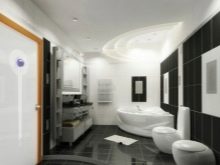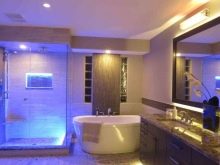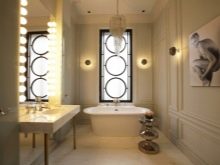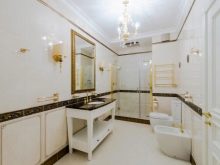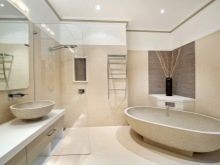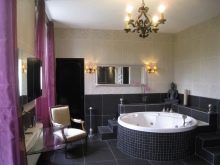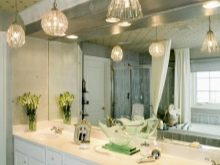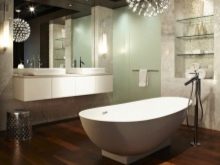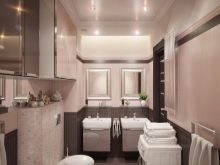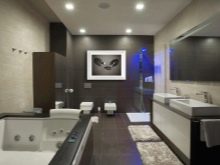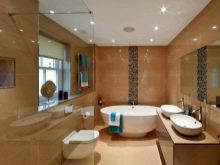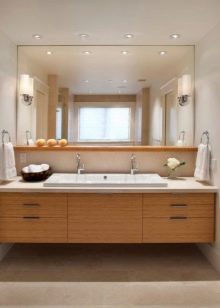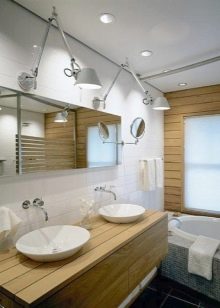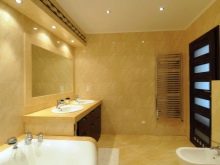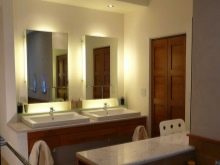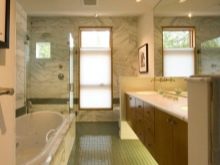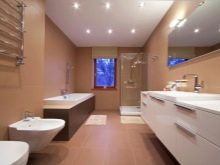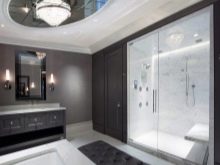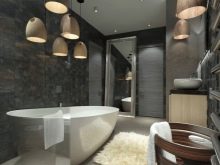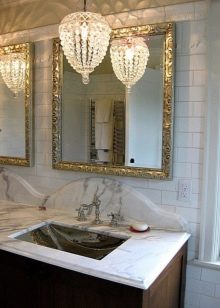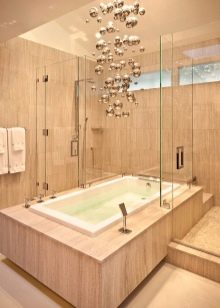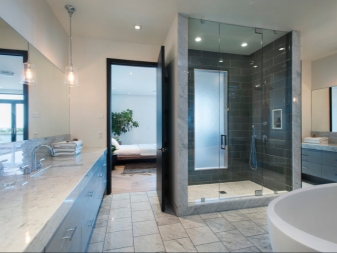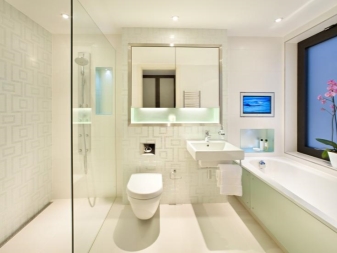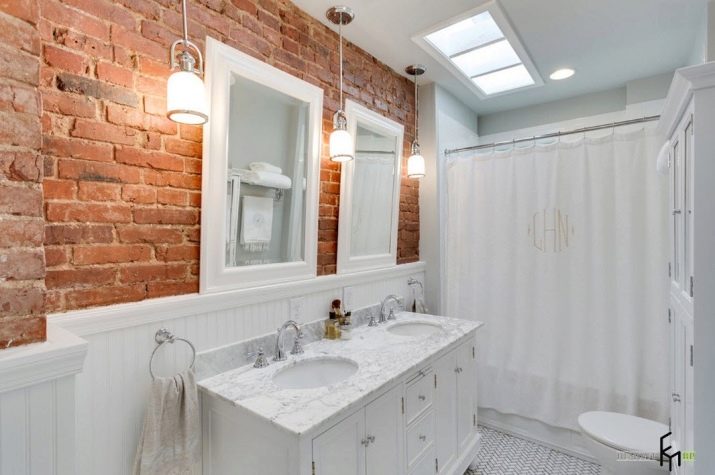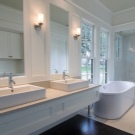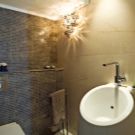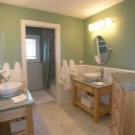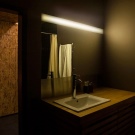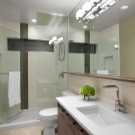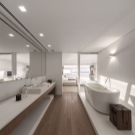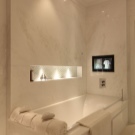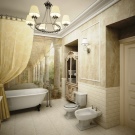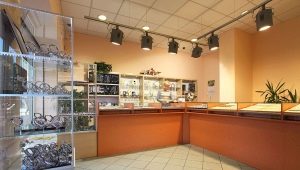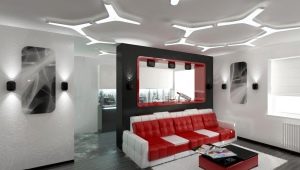Fixtures in the bathroom to the ceiling
A bright and cozy house, in which you want to return again and again, is, of course, the dream of any owner. The choice of lighting in this matter is of great importance. Therefore, the question of how to choose the right lighting fixture in the bathroom and what characteristics you need to take into account, as relevant as ever.
Functions
Like other rooms in the house, the bathroom should be well lit. The light in the bathroom can not be too bright, so as not to irritate sensitive eyes, which is why the best option would be to use ceiling lighting. The light of such lamps does not hit the eyes, and they do not take up additional space, as they are attached directly to the ceiling.
Ceiling lights have many advantages. And one of them is that they are easy to fit into a single style of the bathroom, dividing it into special functional areas. There can be several such zones at once: the area above the bath or shower, above the sink and mirror, as well as the free zone.
For every corner of the bathroom you need lighting of different intensity.
For example, it is better to place a lamp above the sink with an intense light supply, and less bright above the bathroom. This placement of accents is associated with the functional features of the ceiling lights. In addition to the function of the decor, lighting can also perform accentuating and general functions. The light focuses on a specific area of the room or covers it in its entirety.
One of the most common options for bathroom ceiling lights are directional light fixtures, the position of which can be changed manually, thereby illuminating the necessary part of the room. Thus, you adjust the luminous flux yourself, which can be very convenient if there are a lot of zones in the bathroom, and there is only one lighting fixture and there is no possibility to install an additional one.
Kinds
Now on the market of lighting devices there are a huge number of models, but all of them are divided into three main types: mortise, mounted and overhead.
Mortise, or recessed, lamps are located in the special holes of the stretch or plasterboard ceiling, forming with it a flat plane. Such lamps usually have a small size and are installed immediately with a set of five pieces.They will easily fit into any bathroom.
Mortise lamps are very popular because they can be used in almost any room and on any surface. According to the style, they are as neutral as possible, because their body is securely hidden in the hole in the ceiling. By the way, the housing built-in lamps made of metal. And it can be as usual copper and aluminum, and elite chrome-plated metals.
Hinged lamps are much more noticeable on the ceiling.
They resemble ordinary chandeliers, only smaller. Such models are no longer placed in the ceiling, but under it at some distance. As a rule, they have a hanging element that hides the power cable and allows you to adjust the direction of light.
Mounted models visually take up a lot of space, so the bathrooms with low ceilings will look cumbersome, which is not the case with overhead lights. Overhead lights are located close enough to the ceiling, but not built into it completely. They are usually installed on ceilings in which holes for the built-in luminaire cannot be formed.
What kind of light bulbs to choose?
There are four main types of light bulbs for lighting.These are LED, halogen, energy-saving light bulbs and reflector incandescent bulbs.
Incandescent bulbs gradually fade into the backgroundThere are several reasons for this. First, they quickly fail, and they have to be changed frequently. Secondly, they require a large amount of electricity, and this entails unwanted cash costs. Finally, incandescent bulbs have a yellowish light, so it is better not to use them in small spaces. In addition, they can not be used for lamps mounted in the ceiling of plasterboard due to the fact that they quickly heat up.
Due to its structure, halogen bulbs are more durable: their duration is about four thousand hours. These bulbs have a compact size at high power. The big advantage of halogen lamps is their price. Compared with incandescent bulbs, they are considered much more affordable. However, they spend a lot of electricity, so saving with such light bulbs will not work.
Energy-saving lamps are now used in every home, and all because of their efficiency.
These bulbs give a very comfortable for the eyes matte light of varying degrees of brightness from warmer to colder.The only drawback is the difficulty of their disposal, which requires special processing procedures.
The most convenient and profitable type of light bulbs are LED lamps. From the obvious advantages of these lighting elements can be distinguished durability and efficiency of use. Light bulbs with LEDs are a little more expensive, but they will last for many years. They are ideal for lighting living spaces, as they do not heat up and give an even cold light, comfortable for the eyes. Reading under such a light becomes much safer, because the eyes do not have time to get tired.
Moisture protection properties
One of the most important properties of bathroom fixtures is moisture protection. An electrician should not let in water for many reasons, one of which is the safety of the lighting device. To protect your health and to protect your apartment from the closure of the electrical network, it is necessary to use special moisture-proof lamps in the bathroom. They are not afraid of water, they do not react to sudden changes in temperature and will last longer than other lighting devices.
According to the international standard of lighting fixtures for baths and kitchens, the luminaire body should be IP 4 to IP 5 in terms of moisture resistance. Only such lamps are protected from water. Moreover, the first type will withstand an indirect hit of a few drops of water, and the second type is able to withstand the ingress of a jet with a strong pressure. The use of lamps with waterproof properties is especially important for families with young children, who usually like to splash water in the bathroom.
Lighting calculation
If we proceed from the established standards, for a medium-sized bathroom a luminaire is needed with the possibility of illumination of approximately 200 lux (where lux is a lux, unit of measurement of illumination in the International System of Units) per square meter of space. Accordingly, a lighting fixture capable of providing 1400 lux is required for a bathroom of 7 squares.
Bathroom size of 5 square meters requires lighting in 1000 lux light flux Approximately the number of lux contains a normal incandescent bulb 75-100 watts. Accordingly, a lamp with one such light bulb can illuminate a small bathroom.
The LED light bulb has a power of up to 3 W, which will provide a luminous flux of 200-220 lx. Accordingly, for lighting a bathroom in 5 squares you will need from three to five LED bulbs.
In spite of the generally accepted European standard, for small Russian bathrooms they set the mark of the lighting standard at 50 lux.
When buying a lamp and light bulbs make sure that they diffuse the necessary amount of light for your bathroom. It is better to know the size of the bathroom in advance and determine approximately what zone you are going to place the lighting fixture in. These parameters will affect the type of luminaire and the number of bulbs that are needed to provide good lighting. As a rule, information about the lighting capabilities of the device is listed in the passport, which is attached to the product. Before buying it is worth exploring. Usually the manufacturer indicates how much space this or that lamp illuminates.
For spacious bathrooms, lighting is suitable, which is provided at once by several built-in light bulbs located along the perimeter of the ceiling.
Features of installation on different surfaces
The method of installation of chandeliers and any other ceiling light sources is determined not only by the type of luminaire. A large role in this matter is played by the type of ceiling and the materials that were used in its creation. It is important to take into account whether it will be a regular concrete ceiling or a special ceiling construction, which is a stretch, batten or suspended ceiling. When installing the lamp, it is also necessary to consider how many centimeters the ceiling construction deviates from the ceiling itself.
Not all types of fixtures are suitable for a conventional concrete ceiling without additional structures. For example, the mortise models simply cannot be installed because they require some depth. But on the mounted and overhead model there are no restrictions, so that they can be safely installed. The only condition is that such lamps should be mounted on special dowels and have a spherical or flat shape.
But the weight of such chandeliers does not matter, because the concrete ceiling can withstand any lighting fixture.
Mortise lamps and light mounted and overhead lamps can be placed on a plasterboard ceiling, inside of which an electrical wire is held to each individual lamp.For each such wire through a switch a certain amount of electricity is diverted. This system is installed simultaneously with the installation of the ceiling plasterboard construction.
Electrical cables for such ceilings are usually placed in a special cable that looks like an accordion-assembled hose. It is installed on the main ceiling to prevent short circuits and to ensure the safety of the use of the lighting device.
When mounted on a plasterboard ceiling of pendant lamps, it is necessary to provide for them additional hanging elements. But the built-in spotlights do not need such elements. For them, it is enough to make special holes in the ceiling, then connect them to the already installed electric wire, and then fix them in the previously prepared sinuses using special mounting “ears” or springs. Such springs help to hook the spotlight to the edges of the prepared hole. The weight of such spotlights should be small, and the length is at least 20 millimeters less than the length of the mounting holes.This is necessary in order to protect the main ceiling from overheating.
Installation of lighting fixtures in slatted ceilings is practically no different from installing fixtures on plasterboard ceilings. There is little difference between the two systems. Rack designs also allow you to hide all internal wires, and most of the fixtures are also mounted on the suspended structure itself. For slatted ceilings, it is also necessary to drill special sinuses and stretch electrical cables, and then connect them to the lighting fixture. Wiring is usually simply fixed on the ceiling arms themselves.
Stretch ceilings will not be able to withstand the weight of even the lightest lighting fixtures.
That is why when installing fixtures in such ceilings, you need to purchase a special bracket. This fastener must be fixed on the main concrete ceiling, pulled through the hole in the additional, i.e. tension, ceiling, and then fix the lamp on it. When installing the luminaire, a special sealing ring is often used, which helps to hide the opening of the additional ceiling, as well as strengthen the junction of the luminaire, the bracket and the stretch ceiling canvas.The sealing ring prevents deformation of the stretch ceiling in case of overheating.
There are also cases when built-in lamps are mounted in the stretch ceiling. In this case, the light bulbs must be installed in the depth of the stretch ceiling so that they do not look out. In other words, the spotlights must be hidden deep into the structure so that their body and the plane of the stretch ceiling lie on the same level.
Location options
In fact, you can place ceiling lights anywhere, because no one gave specific instructions on this matter. In addition, designer fantasy constantly gives us new ideas in interior design, and these new decor solutions, of course, do not evade playing with light.
There are some restrictions on the placement of lamps in high-humidity areas., but they, as a rule, are not stipulated, because this is a matter of course. For example, no one in their right mind and bright memory will install a luminaire next to a faucet or shower hose that is not protected from moisture. Lights can not be located above the bathroom or inside the shower.This is contrary to elementary safety rules. But otherwise (especially as regards the decor) there are no rules, and there are a lot of options. So in this case, everything depends on the imagination of the owner of the bathroom.
Ceiling lights in the bathroom can be arranged in any order. If the light is provided by a single lighting fixture, it is better to place it in the center of the ceiling. In this case, the light will be scattered evenly around the perimeter of the room. You can also use lights with the ability to adjust the direction of the light beam or a lot of point ceiling lights.
It is believed that the use of a volume single chandelier on the ceiling is not suitable for a bathroom, as it hangs quite low and thereby eats up space. However, if the ceiling height allows, you can try this option. Honestly, for all its impracticality, this chandelier looks gorgeous.
Using such models of lamps, you can competently fit into the interior of the bathroom a chandelier with elegant floral motifs and woody motifs, which recently became fashionable again.
Volumetric hanging chandeliers can be located not only in the center of the ceiling, but also on the periphery, thus illuminating only a certain part of the room. Such options for the location of the lamp are necessary for zoning the bathroom. In addition, in some cases, the lighting device can act not only as a source of light, but also as an additional element of decor, combining beauty and practicality. Examples can be seen in the photo.
Of course, in the light zoning of a room, it is necessary to provide each zone with a lighting device. Therefore, it is very often possible to meet a combination of different ceiling and wall lamps within the same bathroom.
You will learn more about the lamps in the bathroom on the ceiling from the following video.
